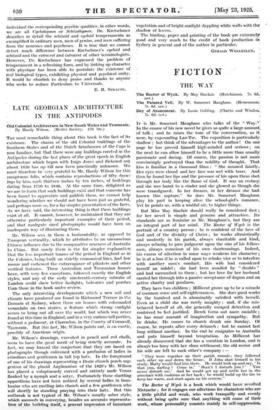LATE GEORGIAN ARCHITECTURE IN THE ANTIPODES
Old Colonial Architecture in New South Wales and Tasmania. By Hardy Wilson. (Medici Society. £10 10s.)
THE most remarkable thing about this book is the fact of its existence. The charm of the old Colonial buildings of the Southern States and of the Dutch farmhouses of the Cape is now familiar, but that there were any buildings erected in the Antipodes during the last phase of the great epoch in English architecture which began with laigo Jones and flickered out about 1850 has up till now been practically unknown. We' Must therefore be very grateful to Mr. Hardy Wilson for this sumptuous folio, which contains reproductions of fifty draw= ings by him, each thirteen inches by ten inches, of buildings' dating from 1700 to 1840. At the same time, delighted as We are to learn that such buildings exist and that someone has been found to appreciate and publish them, we cannot help' Wondering whether we should not have been just as grateful, and perhaps more so, for a far simpler presentation of the facts. As we have said, the interesting thing is that these buildings exist at all. It cannot, however, be maintained that they are otherwise particularly important examples of their period; and that mode; ate sized photographs would have been an inadequate way of illustrating them.
Mr. Wilson secs in them a horizontality, as opposed to European verticality, which he attributes to an unconscious. Chinese influence due to the comparative nearness of Australia" to China. But surely there is the far simpler explanation that the less important houses of the period in England as in the Colonies, being built on strictly economical lines, had loW. rooms and eschewed the extravagance of pilasters and other 'vertical features. These Australian and Tasmanian houses have, with very few exceptions, followed exactly the -English: styles, and any of the early nineteenth-century suburbs of London could show better fanlights, balconies and porches than those in the book under review.
The only interesting developments which a new soil and climate have produced are found in RichmOnd Terrace in the Domain at Sydney, where there are houses with colonnaded verandahs on two stories, a feature which strong sunlight seems to bring out all over the world, but which was never found at this time in England, and in a very curious tall portico, without a pediment, at Clarendon, in the County of Cornwall, Tasmania. But this last, Mr. Wilson points out, is an exotic, possibly of American origin.
Mr. Wilson's drawings,' executed in pencil and red chalk, Seem to have the great merit of being strictly accurate. In fact, we may hazard the conjecture that they are based on photographs though enlivened with a profusion of ladies in crinolines and gentlemen in tall top hats. In the foreground of one of his drawings representing a Doric church porch sug- gestive of the placid Anglicanism of the 1820's Mr. Wilson has placed a voluptuously curved and entirely nude Venus flanked by a nymph and a satyr. Fortunately these startling apparitions have not beeti noticed by several ladies in bom- bazine who are rustling into church and a few gentlemen who will shortly be standing praying into their hats. But this outbreak is not typical dr Mr. Wilson's usually sober style, which succeeds in conveying, besides an accurate representa- tion of the building itself, a general impression of luxuriant
vegetation and of bright sunlight dappling white Walls with the • shadow of leaves.
The binding, paper and printing of the book are extremely good and very mud' to the credit of book production in Sydney in general and of the author in particular.
GERALD WELLESLEY.










































 Previous page
Previous page